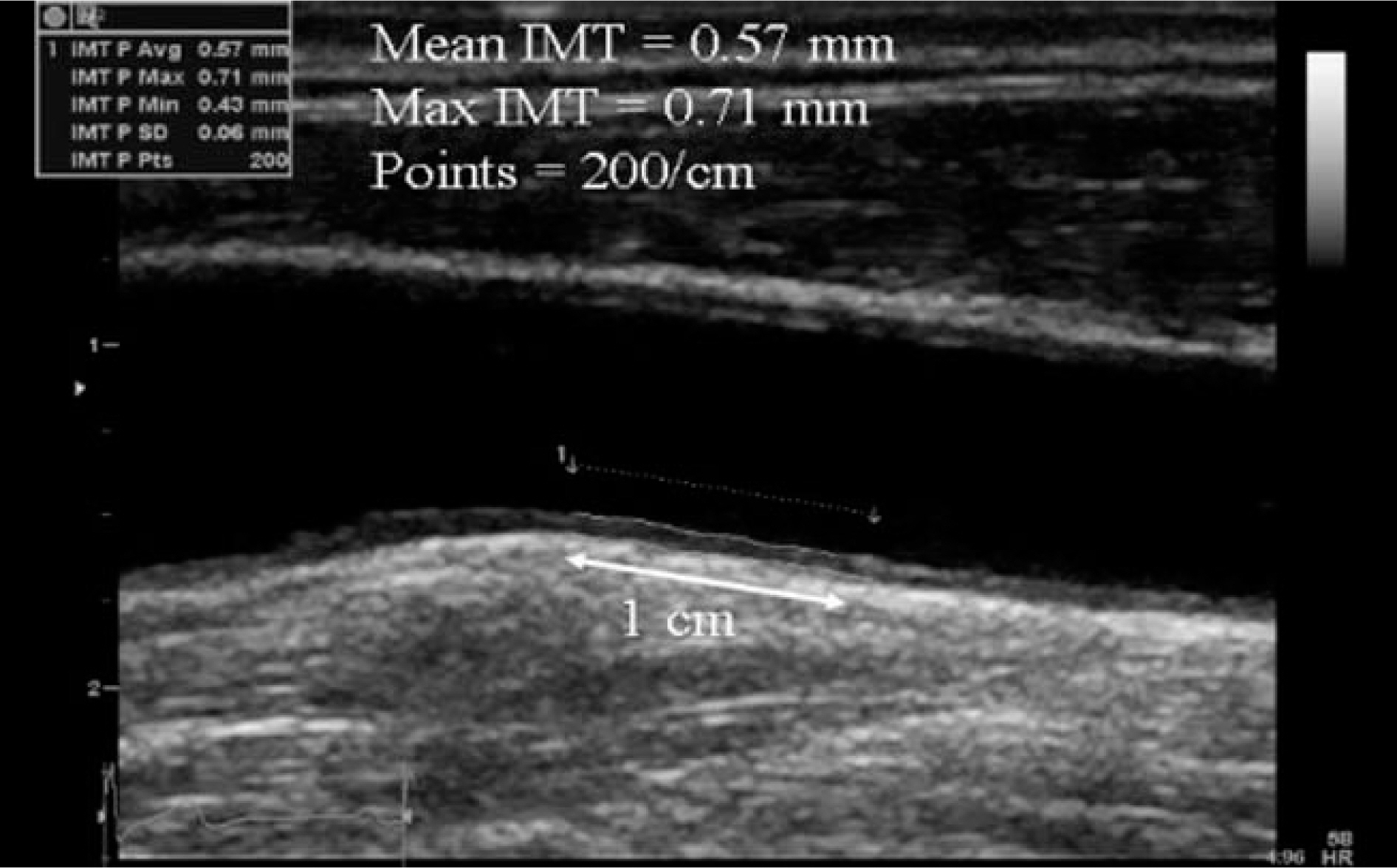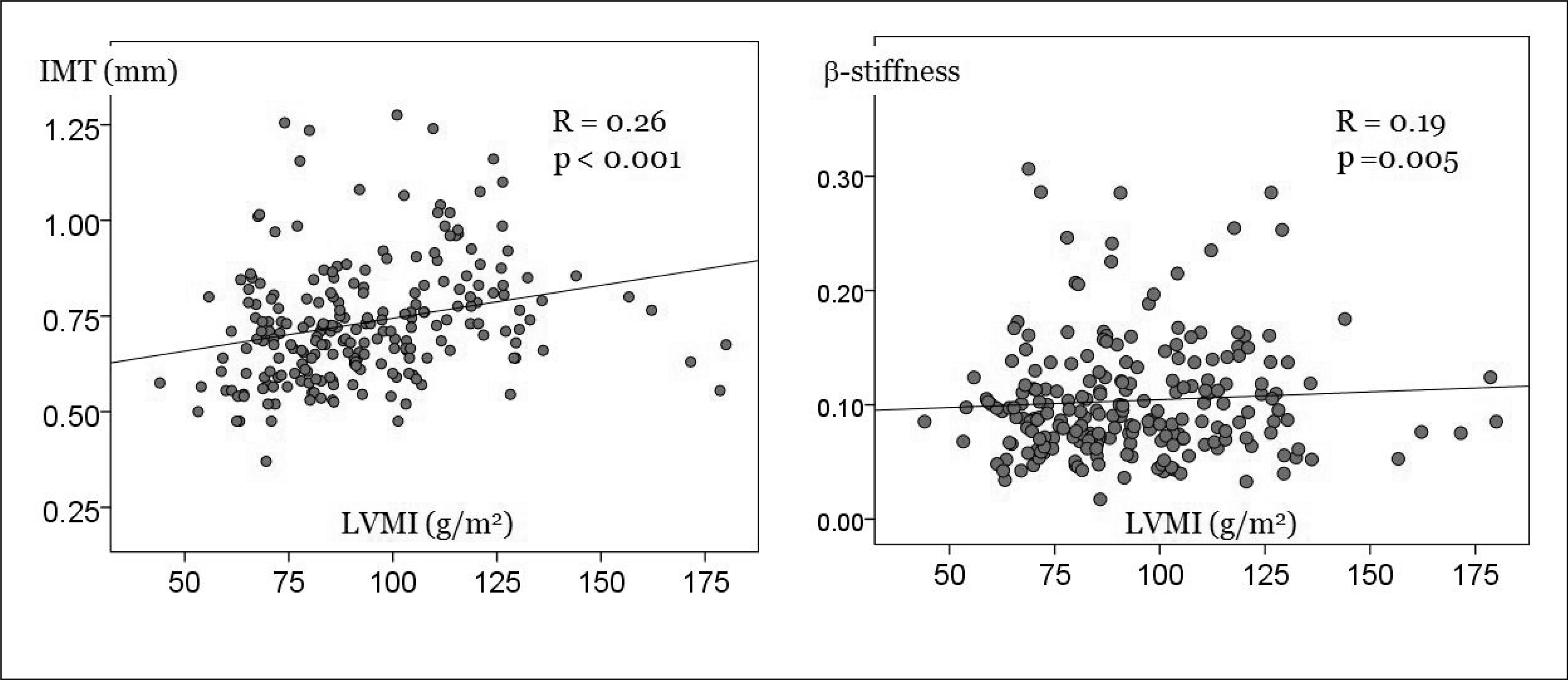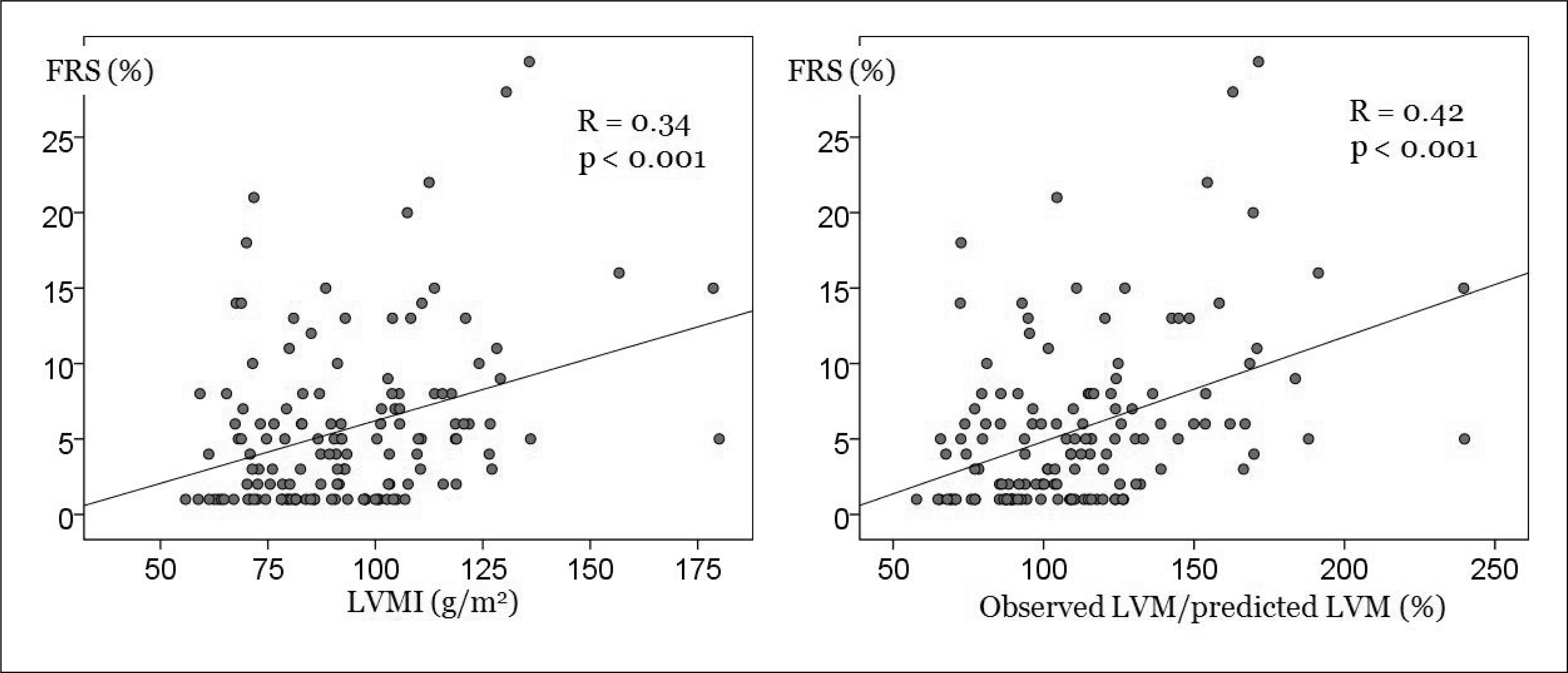J Korean Soc Hypertens.
2013 Sep;19(3):81-89. 10.5646/jksh.2013.19.3.81.
Relation of Inappropriate Left Ventricular Hypertrophy on Framingham Risk Score and Vascular Stiffness in Hypertensive Women
- Affiliations
-
- 1Division of Cardiology, Department of Internal Medicine, Seoul National University Hospital, Seoul National University College of Medicine, Seoul, Korea.
- 2Division of Cardiology, Department of Internal Medicine, Seoul National University Bundang Hospital, Seoul National University College of Medicine, Seongnam, Korea. cardioch@snu.ac.kr
- KMID: 1500276
- DOI: http://doi.org/10.5646/jksh.2013.19.3.81
Abstract
- BACKGROUND
Although left ventricular hypertrophy (LVH) is a compensatory process to pressure overload, there are gender differences in left ventricular function and vascular stiffness in hypertension. We evaluated that inappropriate LVH was related with Framingham risk score (FRS) and vascular stiffness in hypertensive women.
METHODS
Total 226 hypertensive women consecutively underwent carotid ultrasound and echocardiography, from which LV mass (LVM), carotid intima-media thickness (IMT) and beta-stiffness were measured. Inappropriate LVH was calculated by the ratio of observed LVM to the value predicted for sex, height and stroke work at rest and defined as > 128% of predicted. FRS was obtained using by National Cholesterol Education Program Adult Treatment Panel III.
RESULTS
Of 226 subjects, 59 subjects (26%) had inappropriate LVH. As compared with appropriate LVH, subject with inappropriate LVH showed older age, higher FRS, and IMT. Although LV ejection fraction was not different, diastolic parameters of E/A ratio and left atrial volume were significantly worse in inappropriate LVH group.
CONCLUSIONS
The presence of inappropriate LVH in hypertensive women was strongly associated with higher FRS, decreased diastolic function and increased IMT, which might influence future cardiovascular events.
MeSH Terms
Figure
Cited by 1 articles
-
The Accuracy of Electrocardiogram Criteria for Left Ventricular Hypertrophy in Korean Cohort (Atherosclerosis Risk of a Rural Area Korean General Population)
Min-Soo Ahn, Byung-Su Yoo, Ji Hyun Lee, Jun-Won Lee, Young Jin Youn, Sung Gyun Ahn, Jang-Young Kim, Seung-Hwan Lee, Jung han Yoon, Kyung-Hoon Choe, Sang-Beak Koh, Song Vogue Ahn, Jong-ku Park
J Korean Soc Hypertens. 2013;19(4):112-122. doi: 10.5646/jksh.2013.19.4.112.
Reference
-
References
1. Levy D, Garrison RJ, Savage DD, Kannel WB, Castelli WP. Prognostic implications of echocardiographically determined left ventricular mass in the Framingham Heart Study. N Engl J Med. 1990; 322:1561–6.
Article2. Haider AW, Larson MG, Benjamin EJ, Levy D. Increased left ventricular mass and hypertrophy are associated with increased risk for sudden death. J Am Coll Cardiol. 1998; 32:1454–9.
Article3. Verdecchia P, Carini G, Circo A, Dovellini E, Giovannini E, Lombardo M, et al. Left ventricular mass and cardiovascular morbidity in essential hypertension: the MAVI study. J Am Coll Cardiol. 2001; 38:1829–35.
Article4. Kim YJ. Role of echocardiography in hypertensive patients. J Korean Soc Hypertens. 2010; 16:9–18.
Article5. De Simone G, Verdecchia P, Pede S, Gorini M, Maggioni AP. Prognosis of inappropriate left ventricular mass in hypertension: the MAVI Study. Hypertension. 2002; 40:470–6.6. Palmieri V, Wachtell K, Gerdts E, Bella JN, Papademetriou V, Tuxen C, et al. Left ventricular function and hemodynamic features of inappropriate left ventricular hypertrophy in patients with systemic hypertension: the LIFE study. Am Heart J. 2001; 141:784–91.
Article7. Libhaber CD, Norton GR, Maseko MJ, Majane OH, Millen AM, Maunganidze F, et al. Relationship between inappropriate left ventricular hypertrophy and ejection fraction independent of absolute or indexed mass in a community sample of black African ancestry. J Hypertens. 2013; 31:169–76.
Article8. Muiesan ML, Salvetti M, Paini A, Monteduro C, Galbassini G, Bonzi B, et al. Inappropriate left ventricular mass changes during treatment adversely affects cardiovascular prognosis in hypertensive patients. Hypertension. 2007; 49:1077–83.
Article9. Roman MJ, Pickering TG, Schwartz JE, Pini R, Devereux RB. Association of carotid atherosclerosis and left ventricular hypertrophy. J Am Coll Cardiol. 1995; 25:83–90.
Article10. Polak JF, Pencina MJ, Pencina KM, O’Donnell CJ, Wolf PA, D’Agostino RB Sr. Carotid-wall intima-media thickness and cardiovascular events. N Engl J Med. 2011; 365:213–21.
Article11. Vlachopoulos C, Aznaouridis K, Stefanadis C. Prediction of cardiovascular events and all-cause mortality with arterial stiffness: a systematic review and meta-analysis. J Am Coll Cardiol. 2010; 55:1318–27.12. Sohn IS, Lee JB, Cho BH, Park JH, Jin ES, Cho JM, et al. Carotid intima-media thickness and arterial stiffness in hypertensive patients with first attack of ischemic stroke. J Korean Soc Hypertens. 2010; 16:14–21.13. G De Simone, RB Devereux, TR Kimball, GF Mureddu, MJ Roman, F Contaldo, et al. Interaction between body size and cardiac workload: influence on left ventricular mass during body growth and adulthood. Hypertension. 1998; 31:1077–82.14. G De Simone, Daniels SR, Devereux RB, Meyer RA, Roman MJ, de Divitiis O, et al. Left ventricular mass and body size in normotensive children and adults: assessment of allometric relations and impact of overweight. J Am Coll Cardiol. 1992; 20:1251–60.15. Peterson LH, Jensen RE, Parnell J. Mechanical properties of arteries in vivo. Circ Res. 1960; 8:622–39.
Article16. Kawasaki T, Sasayama S, Yagi S, Asakawa T, Hirai T. Non-invasive assessment of the age related changes in stiffness of major branches of the human arteries. Cardiovasc Res. 1987; 21:678–87.
Article17. Asanoi H, Sasayama S, Kameyama T. Ventriculoarterial coupling in normal and failing heart in humans. Circ Res. 1989; 65:483–93.
Article18. Kelly RP, Ting CT, Yang TM, Liu CP, Maughan WL, Chang MS, et al. Effective arterial elastance as index of arterial vascular load in humans. Circulation. 1992; 86:513–21.
Article19. Chen CH, Fetics B, Nevo E, Rochitte CE, Chiou KR, Ding PA, et al. Noninvasive single-beat determination of left ventricular end-systolic elastance in humans. J Am Coll Cardiol. 2001; 38:2028–34.
Article20. Go AS, Mozaffarian D, Roger VL, Benjamin EJ, Berry JD, Borden WB, et al. Executive summary: heart disease and stroke statistics–2013 update: a report from the American Heart Association. Circulation. 2013; 127:143–52.21. Senni M, Tribouilloy CM, Rodeheffer RJ, Jacobsen SJ, Evans JM, Bailey KR, et al. Congestive heart failure in the community: a study of all incident cases in Olmsted County, Minnesota, in 1991. Circulation. 1998; 98:2282–9.22. Masoudi FA, Havranek EP, Smith G, Fish RH, Steiner JF, Ordin DL, et al. Gender, age, and heart failure with preserved left ventricular systolic function. J Am Coll Cardiol. 2003; 41:217–23.
Article23. Shim CY, Park S, Choi D, Yang WI, Cho IJ, Choi EY, et al. Sex differences in central hemodynamics and their relationship to left ventricular diastolic function. J Am Coll Cardiol. 2011; 57:1226–33.
Article24. Tan YT, Wenzelburger F, Lee E, Heatlie G, Leyva F, Patel K, et al. The pathophysiology of heart failure with normal ejection fraction: exercise echocardiography reveals complex abnormalities of both systolic and diastolic ventricular function involving torsion, untwist, and longitudinal motion. J Am Coll Cardiol. 2009; 54:36–46.25. Roman MJ, Pickering TG, Schwartz JE, Pini R, Devereux RB. Relation of arterial structure and function to left ventricular geometric patterns in hypertensive adults. J Am Coll Cardiol. 1996; 28:751–6.
Article
- Full Text Links
- Actions
-
Cited
- CITED
-
- Close
- Share
- Similar articles
-
- Effect of Left Ventricular Hypertrophy on Ventricular Performance in Essential Hypertension
- A Comparative Study of Left Ventricular Diastolic Function between Hypertrophic Cardiomyopathy and Hypertensive Patients with Left Ventricular Hypertrophy
- Left Ventricular Diastolic Functions by M-Mode Echocardiogram in Essential Hypertensive Patients
- Interrlationship between Left Ventricular Mass and Diurnal Variations of Blood Pressure in Patients with Esssntial Hypertension
- Left Ventricular Hypertrophy and Prelude to Hypertensive Cardiovascular Diseases; from the Pediatric Cardiologist's Point of View





